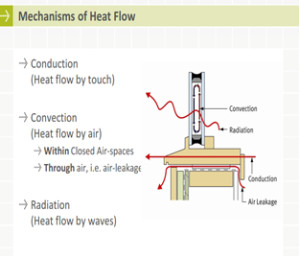There are three principal mechanisms of heat transfer through materials, components and assemblies which make up the building enclosure;
Conduction:
Is the transfer of energy through a material and between materials that are in direct contact to each other.
Reducing the number of thermal bridges through the building insulation, by design and detailing, and by material and assembly choice (stick build vs. prefab) is essential if a building is to have good thermal performance.
Radiation:
Is the transfer of energy through a gas or a vacuum, in form of electromagnetic waves. It is the process where a warm/hot surface radiates heat to a colder surface. Both the temperature of the two surfaces and the emissivity of the materials affect the amount of heat loss.
Radiation can be reduced from a surface by reducing its emissivity, for example, by using a low-emissivity (low-e) coating on a glass surface within an insulated glass unit (IGU).
Convection:
Is the transfer of energy by the movement of a fluid such as air. Convective heat transfer for building enclosures has two primary mechanisms; convective flow of air within assemblies or spaces, and convective flow through assemblies from interior to exterior or exterior to interior.
This form of convection is generally known as air leakage.
The convective heat transfer can be minimized through use of airspaces of an optimum air space of approximately 12mm (1/2”) and use of denser fill gases such as argon in IGU’s.
Convection due to air movement through assemblies or air leakage is a significant portion of heat loss in a building and could be up to 50% of the total heat loss through air leakage.
-Use of the site, features of the building, and glazing properties to optimize the effects of solar radiation.
-Minimizing conductive losses through the opaque wall areas through the use of insulating materials, avoidance of thermal bridging and the use of low conductivity window/door frames and glazing
-Limiting unintentional air flow through the elements of the building envelope.

